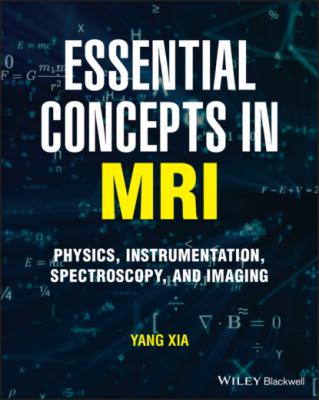ТОП просматриваемых книг сайта:
Essential Concepts in MRI. Yang Xia
Читать онлайн.Название Essential Concepts in MRI
Год выпуска 0
isbn 9781119798248
Автор произведения Yang Xia
Жанр Медицина
Издательство John Wiley & Sons Limited
Figure 3.1 The quantities in a spin-1/2 system. The application of an external magnetic field B0 introduces two energy levels for the spin-1/2 system. The population difference between the two states, determined by the Boltzmann distribution, results in a macroscopic magnetization, M, pointing along the same direction as the external magnetic field.
The terms “spin-up” and “spin-down” refer to the z-component mħ of the angular momentum. The actual spin vector has a magnitude of ℏI(I+1), which is greater than mħ. Hence, a spin vector I cannot lie graphically along any fixed axis in space. This is the reason that the precessional motion of a nucleus spin in a classical description is tilted at a fixed angle (Figure 2.3b). Since Ix, Iy, and Iz do not commute, we cannot specify or measure any two quantities simultaneously. Only the z-component Iz and the magnitude of I are known with certainty as Iz = 1/2 and I2 = 3/4, which can be used to determine the fixed angle of the cone in Figure 2.3b and Figure 2.4b.
Instead of visualizing a vector µ precessing on the surface of a cone, a spin vector in the stationary state can be thought of as uniformly smeared out over the surface of a cone, similar to the advanced concept in modern physics that visualizes an electron as a cloud around a nucleus instead of a point charge in an orbit around the nucleus. In addition, quantum mechanically, a nuclear spin in a stationary state does not precess, since the probability density and expectation values are independent of time. Since I is uniformly smeared out as described and cannot be specified to lie completely along any axis, we should only be concerned with the components of I, not I itself. Therefore, the spin-up state can be thought of as a spin vector lying along the z axis, parallel with the field direction.
3.3 MACROSCOPIC MAGNETIZATION
Any practical sample, no matter how small, contains an enormous number of nuclei. It is the macroscopic ensemble average of the observable quantities in which we are interested. In these ensembles, different nuclei may occupy different states |ψ>. We use the concept of sub-ensemble in which all nuclei are in identical states |ψ(t)>. The sum over all sub-ensembles, each with a classical probability pψ, gives the observable ensemble average in which we are interested. The averaged expectation value, by definition, is
where the bar refers to the statistical ensemble average, and the pair of arrow brackets, < >, represents the quantum mechanical expectation value.
Now consider spin-1/2 particles. In NMR, the dominant interaction of a spin with its environment is always via the Zeeman interaction [as in Eq. (3.5)]. This means that the natural eigenstates are those whose quantum numbers are eigenvalues of Iz, that is, |1/2> and |–1/2>.
In general, we can express any state in this basis using the Pauli’s spin matrices formalism (cf. Appendix A2.5), as
Since Iz=12[100−1], the ensemble averaged expectation value of Iz is determined by the difference in populations between the upper and lower energy levels, according to the Boltzmann distribution. This distribution describes the polarization of the ensemble in thermal equilibrium.
We can calculate the normalized population at thermal equilibrium as
where the numerators are individual populations and the denominator is the total population.
Note that kBT is the Boltzmann energy and ħγB0 is the Zeeman energy difference. For example, for protons in a magnetic field of strength B0 = 7 Tesla and at room temperature (T = 300 K), we have
Since kBT is over four orders of magnitude bigger than ħγB0, the ratio ħγB0/kBT is tiny. This is a good news and bad news situation: the good news is that the exponentials in Eq. (3.14) can be simplified using the Taylor expansion since the high-order terms would be very small, while the bad news means that our signal will be very small, since the signal is proportional to the population difference.
Due to this tiny ratio between the Zeeman energy and the Boltzmann energy, we can apply the Taylor expansion (Appendix A1.1.4) to simplify the expression in Eq. (3.14) by keeping only the first two terms, as
This equation at the room temperature and a 7 Tesla B0 equals approximately 0.5 ± 1.12 × 10-5, which is almost a half and half situation between the two populations. This approximation is known as the “high-temperature approximation” in the NMR literature, except the “high temperature” in this estimation actually means the room temperature.
3.4 MEASUREMENT OF THE X COMPONENT OF ANGULAR MOMENTUM
In Appendix A2.6, we introduce the concept of density matrix operator ρ, which relates the expectation value of any operator A

